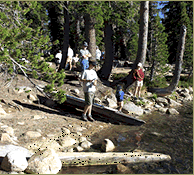Yosemite: Management Problems and Issues
|
• With development and a boost in domestic travel after the Sept. 11 terrorist attacks, visits to the Park are increasing and changing direction. The Park sees 3.5 million visitors annually. Thirty years ago, 80 percent of Yosemite's visitors stayed overnight; now, it's 80 percent day-use.
• The number of roads and facilities have been increased to keep pace with the growing visitor numbers and to supply amenities, infrastructure and parking lots for all these tourists. These actions have caused habitat loss in the park and are accompanied by various forms of pollution including air pollution from car emissions. Environmentalists have reported "smog so thick that Yosemite Valley could not be seen from the air". This occasional smog is harmful to all species and vegetation inside the Park. (Source: Trade and Environment Database) • Vehicle traffic has increased about 30 percent over the last decade. Seven bears were killed by cars on park roads in 2003. • Development continues to encroach on park boundaries, bringing new housing projects and commercial construction - and thousands more people. The newly opened Chukchansi Casino, one of the state's largest, is just 30 miles down the road, advertising with billboards throughout the region: "Now, Yosemite has a night life." And with the recently approved SilverTip Resort Village, a 47-acre commercial and residential complex slated to go up in the tiny park border town of Fish Camp. • Noise pollution from vehicles and campsites rivals the Park's natural noises (Yosemite National Park Planning Update). Buildings, roads, and parking lots have marred the aesthetic beauty of the Valley, while visitors are often stuck in traffic hoping to find a parking spot.
• Areas of river banks close to camp sites have been eroded by visitors, destroying natural habitats. • The importance of tourism to the local economy can be illustrated by the impact of the catastrophic 1997 floods that temporarily closed the Park. This caused locally severe economic losses to the areas around the Park. In the most heavily impacted area, Mariposa County, 1997 personal income was reduced by an estimated US$1,159 per capita (US$18 million for the entire county) - a 6.6% decline. The county was also estimated to have lost US$1.67 million in county occupancy and sales tax revenues, and 956 jobs, a significant number in a county of fewer than 16,000 residents. • The Ahwahneechee indigenous Indians have not received any compensation in the form of money nor land for their loss of the Yosemite area in 1851.
Sources: thedesertsun.com
| Yosemite presses on with massive restoration |
|||
|


